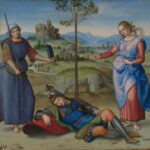Raffaello (1483-1520)
Le Tre Grazie (The Three Graces)
c.1504–1505
Oil on panel, 17 x 17 cm
Musée Condé, Chantilly
This is one of the smallest paintings by the master and the only secular work from Raphael‘s Florentine period, before 1508, still under the influence of Pinturicchio and Perugino. The attribution to Raphaël has never been called into question. He appeared in 1693 under the name of Raphael in the inventory of Cardinal Scipio Borghese (1576-1633) alongside the Knight’s Dream (London, National Gallery), then entitled the Three Virtues. It was acquired around 1800 by Henri Reboul (1763-1839), intendant of the Roman Republic under Bonaparte, who brought it back to France in 1803. It passed to England where the Duke of Aumale acquired it in 1885. Scientific analysis showed repentance; originally, only the figure on the left held a golden apple, the central figure had his arm resting on the shoulder of the woman on the right. Since there was only one golden ball, it could have been a judgment of Paris with the three most beautiful goddesses of Olympus, Diana, Juno and Venus, the shepherd Paris appearing on the London panel. Raphael was inspired by an antique marble which was found in 1502 in Siena in the bookstore of Pope Pius II Piccolomini, and another copy of which is in the Louvre. In Greco-Roman mythology, the three Graces are daughters of Jupiter embodying beauty, seduction, and fertility. This subject, popular in Antiquity, was often treated during the Renaissance. The three golden globes may refer to the Hesperides, daughters of Atlas and Hesperis to whom Juno entrusted the golden apples of immortality, the reward of virtue, which Hercules had to conquer during his labors, despite the dragon that Hera had placed in the garden to protect them. The three golden balls could allude to the Medici arms and symbolize the image of the courtier: “Wisdom, Power, Beauty” defined by Balthazar Castiglione in the Courtier, a book written during a stay in Urbino between 1503 and 1506 in which we recognize Giuliano de Medici who would then be the sponsor of the painting. The Knight’s Dream, a counterpart to the Three Graces, is also differently interpreted. It perhaps shows the Dream of Scipio Africanus, an ancient poem by Silius Italicus famous in Florence in the 16th century: Scipio must choose between the difficult path of virtue and the more cheerful path of love and pleasure. The Three Graces, holding the golden apples from the garden of the Hesperides, symbol of immortality, represent the reward of the virtuous man. It could also be the ancient representation of Hercules at the crossroads between Love and Duty, in the form of two feminine allegories. It would be an exhortation to virtue for the young Scipio Borghese, born in 1493, on the occasion of his communion in 1500. The London panel would evoke the masculine virtues (Justice, Strength, Temperance) and that of Chantilly the feminine virtues ( Love, Beauty and Modesty). (Musée Condé)
Pair:
 Raffaello (1483-1520)
Raffaello (1483-1520)
Il sogno del cavaliere
c.1504
National Gallery, London
